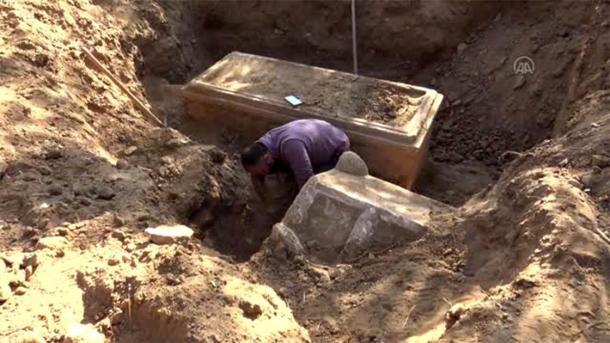Late Roman Era Sarcophagus Found By Turkish Farmer
A project in Turkey to stop illegal excavations has resulted in the discovery of rare sarcophagi. To detect the looters, the authorities used the new surveillance technologies, which in turn led to these unexpected discoveries.
The findings are related to Aphrodisias and may have originated from a part of the ancient city that was previously unknown.
Turkish authorities have been notified of possible illegal excavations in Karacasu, a town near Aphrodisias, a Hellenistic-era city and a UNESCO World Heritage Site, in western Turkey.


Officials decided to monitor the activities of the looters by setting up motion-sensitive cameras to detect any possible criminal activity. Drones were also employed as part of the operation.
After weeks of surveillance, a group of men was detected in the area. The local gendarmerie investigated and uncovered signs of an illegal excavation in an olive grove. Further investigations revealed a half-unearthed sarcophagus.
The authorities immediately placed the site under their protection. Further investigations also revealed another sarcophagus and an altar.
Surveillance Operation Uncovers Illegal Excavation
The district governor Ahmet Soley is quoted by Archaeology News Network as saying that groups of people were coming from elsewhere and were engaging in suspicious activity. “As a result of the gendarme’s work, the places to be excavated were found and two sarcophagi, along with an altar, were discovered in the area.”
However, the treasure hunters behind the illegal excavation got away. Greece in High Definition reports Soley as saying that “the perpetrators of the illegal diggings are still unclear.”
One of the sarcophagi is better preserved than the other and still has many of its original decorations. According to Greece in High Definition, the Provincial Culture and Tourism Director Umut Tuncer announced that “there is a Medusa relief among others that have not yet been identified on one of the sarcophagi.” The identity of the person who was buried in this tomb has not been established.

Given the size of the sarcophagus, it is likely that the person interred was a member of the local elite. Tuncer is quoted by Archaeology News Network as explaining that the authorities believe that “the person in this sarcophagus was an important figure of the region.” It is estimated that the burials date back to at least 2,300 years ago to the Hellenistic era.
The finds are probably connected to the city of Aphrodisias, an ancient Greek City named after the Goddess of Love, Aphrodite.
The city grew wealthy because of its rich agricultural hinterland. Aphrodisias was also famed for its marble and its school of sculptors.
The city became part of the Roman province of Caria and it was favored by Sulla and Julius Caesar. As a result, it was largely autonomous. The city’s name after the rise of Christianity was “changed to Stavropolis and then Caria, and it became the seat of the metropolitan bishop of Caria,” explains an entry in the Encyclopaedia Britannica.
It went into decline and was abandoned during the Seljuk Turk invasions of Anatolia in the Middle Ages.
The discovery of the sarcophagus means that it is likely that other burials could be found. But that’s not all! Experts also believe that the sarcophagus has revealed a new part of the city. This could mean that even more important finds and long-lost structures could be recovered at a future date.
The remains of the city of Aphrodisias are now part of an archaeology park, the centerpiece of which is the remains of a temple of Aphrodite. Thanks to its UNESCO designation, the park is very popular with tourists which has become increasingly important for the local economy.
The unexpected find has created excitement amongst local authorities as “the discovery of a new metropolitan area creates great potential in terms of regional tourism,” highlights Tuncer in Archaeology News Network.
The thrilling discoveries demonstrate the threat posed by illegal excavations and how technology can play a critical role in the prevention of this crime.
